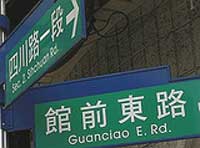 With Taiwan’s presidential election less than six months away and various position papers being issued, perhaps it’s time to take a look at where the opposition stands on romanization.
With Taiwan’s presidential election less than six months away and various position papers being issued, perhaps it’s time to take a look at where the opposition stands on romanization.
Sure, various politicians rant from time to time. But they may or may not be taken seriously. What about the party itself and its candidate?
Google doesn’t find any instances of “拼音” (“pīnyīn”) on the official Web site of the Democratic Progressive Party’s presidential candidate, Tsai Ing-wen (Cài Yīngwén / 蔡英文). But searching for “拼音” on the DPP’s official Web site does yield at least a few results. (See the “sources” at the end of this piece.) It’s probably no surprise that none of them contain anything but bad news for those who support Taiwan’s continued use of Hanyu Pinyin.
Typical is the “e-paper” piece from 2008 that states the change to Hanyu Pinyin will cost NT$7 billion (about US$240 million). (If the DPP candidate wins, will the DPP follow its own assertions and logic and say that it would be far too expensive for Taiwan to change from the existing Hanyu Pinyin to Tongyong Pinyin?) I have no more faith in that inflated figure than I have in the other claims there, such as that the use of Hanyu Pinyin would not be convenient for foreigners and that there is no relationship between internationalization and using the world’s one and only significant romanization system for Mandarin (Hanyu Pinyin).
Then there’s the delicious irony that the image of a Tongyong Pinyin street sign the DPP chose to use in that anti-Hanyu Pinyin message has a typo! The sign, shown at top right, should read Guancian, not Guanciao. (In Hanyu Pinyin it would be “Guanqian.”) That’s right: The DPP says Taiwan needs to use Tongyong — but the supposed expert who put together that very argument apparently doesn’t know the difference between Tongyong Pinyin and a hole in the wall..
That document is a few years old, though. What about something more recent? Just three months ago the DPP spokesman, Chen Qimai (Chen Chi-mai / 陳其邁), complained that the Ma Ying-jeou administration had replaced Tongyong Pinyin with Hanyu Pinyin, calling this an example of removing Taiwan culture and abandoning Taiwan’s sovereignty. So there’s nothing to indicate a change in position over time.
It’s worth remembering that there’s a lot of blame to go around for the inconsistencies and sloppiness that characterize Taiwan’s romanization situation. Historically speaking, the KMT is certainly responsible for much of the mess. And the Ma administration’s willingness to go along with “New Taipei City” instead of “Xinbei,” “Tamsui” instead of “Danshui,” and “Lukang” instead of “Lugang” demonstrates that it is OK with cutting back its own policy in favor of Hanyu Pinyin. Nevertheless, it’s now the DPP — or at least some very loud and opinionated people within it — that represents the main force for screwing up perfectly good signage, etc.
Back when I was more often around DPP politicians, I would occasionally ask them privately about their opinions of Hanyu Pinyin. For the most part, they had no opposition to Taiwan’s use of it, regarding this as simply a practical matter. But they would not say so publicly because President Chen Shui-bian’s dumping of Ovid Tzeng made it clear what fate would meet those who opposed Chen on this issue.
Even though Chen is no longer in the picture, I fear that many in the DPP have come to believe their own propaganda on this issue.
I urge individuals (esp. those with known pro-green sentiments) and organizations (Hey, ECCT and AmCham: that means you especially!) that want to avoid a return to the national embarrassment that is Tongyong Pinyin to tell Cai Yingwen and the DPP now that Taiwan’s continued use of Hanyu Pinyin is simply good policy and is supported by the vast majority of the foreign community here, including pro-green foreigners.
sources:
- Mínzhǔ Jìnbùdǎng dì-shísān jiè dì-jiǔ cì zhōngcháng huì xīnwéngǎo (民主進步黨第十三屆第九次中常會新聞稿), official DPP Web site, October 1, 2008
- Cǎiyòng Hànyǔ Pīnyīn shì wénhuà bǎn de CEPA pīn yìshi xíng tài ér fēi pīn jīngjì (採用漢語拼音是文化版的CEPA 拼意識型態而非拼經濟), official DPP Web site, September 30, 2008
- Chén Qímài: Mǎ zǒngtǒng xuǎn qián ài Táiwān, xuǎn hòu què pínpín qù Táiwān (陳其邁:馬總統選前愛台灣,選後卻頻頻去台灣), official DPP Web site, May 24, 2011
- Zhèngzhì gǎicháohuàndài, Zhōngwén yìyīn xìtǒng yěděi gǎi! (政治改朝換代,中文譯音系統也得改!), DPP e-paper (民進黨電子報), October 9, 2008
